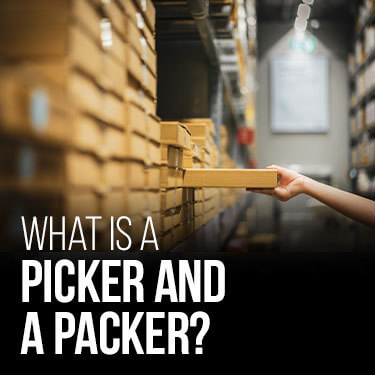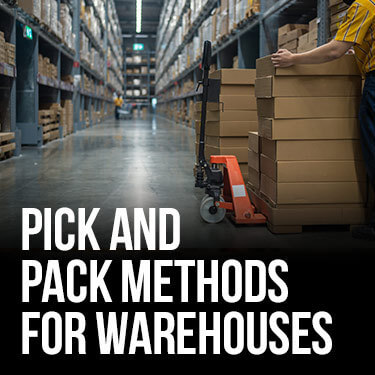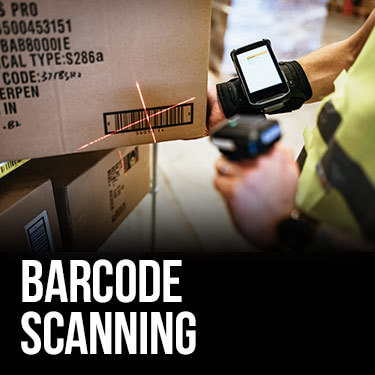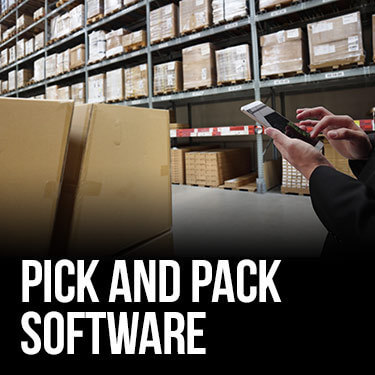
 Copy URL to Clipboard
Copy URL to Clipboard
All warehouses, from home garages used for small businesses, to massive, automated facilities, rely on picking and packing best practices to safely and efficiently move merchandise from shelving to shipping. If you oversee a warehouse of any size, it’s vital to ensure you’re following the best practices for your pick and pack ship process.
Picking and packing best practices, such as choosing the best picking method for your warehouse, ensuring flow from storage to your shipping area, and use of pick and pack software solutions to minimize errors, will enhance safety and efficiency. These pick and pack practices also result in happy customers and an increased bottom line.
To describe these practices in greater detail, we should first review some basics of a pick and pack warehouse.
Table of Contents
On a fundamental level, the concept of a pick and pack warehouse is self-explanatory: the warehouse is used to store goods, workers pick merchandise from the shelf and/or other storage area, and those products are packed up for shipping to fulfill orders.
Whether you order a small amount of household goods or a large amount of items for resale, it’s likely that some form of pick and pack process is used to get them from the warehouse to you.

In a pick and pack warehouse, pickers take the responsibility of gathering items for shipment. Once items are picked, they’re brought to the packing station, where packers package the items for shipment.
It all starts with picking the items, which is accomplished manually, by use of equipment such as forklifts and pallet jacks, or even automatically via drones and other high-tech machinery. Once picked, the products are staged, packed for shipment, and loaded onto a delivery vehicle.
To examine the pick, pack, and ship process in further detail, read our article on the benefits of a pick and pack warehouse.
Unless you deal with the sourcing and harvesting of raw materials such minerals, metals, and crops, you can think of a pick and pack warehouse as the first step in the supply chain that gets your products to your door. Without an accurate and thoughtfully laid out pick and pack process, warehouses have a greater likelihood of making costly, time-consuming errors.
Looking to partner with the professionals in pick and pack services? Learn more details of pick and pack fulfillment services here.
Any business, regardless of its size, should periodically review warehousing needs and, where applicable, ensure they’re maintaining the best practices for picking and packing.

It should come as no surprise that there’s no universal rule for these best practices. Instead, you should evaluate your existing process (or lack thereof), identify opportunities for improvement, and apply the best practices for your business’s unique needs. To help you do that, we’ll examine the elements of the pick and pack process, offering examples where certain methods may or may not be helpful.
There are four primary methods of picking that are commonly practiced in pick and pack order fulfillment.
Proper warehouse organization is vital to streamlining the pick and pack process, and the best practices for warehouse organization will vary based on the size of the warehouse in question and the diversity of its stored merchandise.
One universal best practice for organizing a pick and pack warehouse is that the floor plan should be optimized for process flow. Keep in mind the old saying, “The shortest distance between two points is a straight line.”
Organizing your warehouse in such a way that items move from receipt to shelving to the shipping line in as straight a path possible doesn’t just improve efficiency, it also cuts down on the possibility of injuries among warehouse workers.
Picking and packing is part of retail fulfillment services. Read our article on the topic to learn more.
Manual picking refers to the practice of picking product by hand, which is a viable option for small warehouses storing small, lightweight goods that usually end up getting shipped to end users. However, as with most elements of picking and packing, scaling up to larger shipments will probably require you to rely on mechanical or automated picking methods.
Obviously, retrieving large, heavy items from storage shelves is most easily accomplished by pickers using equipment such as forklifts and pallet jacks. This is a form of mechanical picking, and a best practice to keep pickers from putting their bodies at risk.
Depending on the volume of orders your warehouse receives and the size of your merchandise, even mechanical picking methods may fall short of achieving your efficiency goals. This is where automation comes in.
Warehouse automation has existed in some form for decades; even the humble conveyor belt counts as an example of this technology. In modern high-volume warehouses, it’s not uncommon to see drones and automated lifts retrieving items for packing. Warehouses that employ extensive automation usually have an edge over their manual counterparts thanks to the reduction in human error.

Simply put, a barcode system is a must for nearly any warehouse. It improves order picking accuracy through the use of barcodes and barcode scanners, which allows for easy evaluation of inventory levels and enhances efficiency across every element of the pick and pack process.
There are two kinds of barcodes used in most warehouse labeling: 1D and 2D. You probably have several examples of 1D barcodes in your home, as they’re used on products to be scanned at retail locations. A 2D barcode looks like a QR code, and can store much more information than a 1D barcode.
The most commonly used 1D barcodes for warehousing and logistics are called code 39 and code 128 barcodes. Of the two, code 128 can store far more information including weight and shipping dimensions, so using a code 128 barcode system is a best practice for large pick and pack warehouses.
Now that we’ve established some of the best practices for organizing and picking items in a warehouse, it’s time to move on to packing.
At a manual packing station, packers package picked products for shipment. Common packing materials include packing tables, tape, boxes, and scales. The best practices for manual packing are largely based on making the process as fast as possible without sacrificing accuracy.
Having all the packaging equipment at arm’s reach, double-checking the accuracy of the picked order, and arranging the packing station so that the packer does not need to bend or twist their body often are among the best practices for manual packing. It’s also a good idea to sanitize the packing area regularly.
Like most aspects of pick and pack warehousing, what was once a strictly manual process now has many automation options available as well.
Automated packing machines include devices that box, wrap, seal, and fill package voids as products approach on a conveyor belt or similar moving platform. Large ecommerce warehouses benefit from automation, as it cuts down on errors in the packing process and reduces labor costs. It’s not uncommon for some packing stations to combine manual and automated packing methods.
The best practices for an automated packing system center around routine maintenance and inspection of the automated equipment. This will help identify potential mechanical issues before they become costly to repair, as well as promote warehouse safety for employees.

Using pick and pack software is vital for all but the smallest warehouses. By automating what would otherwise be a series of laborious manual operations, pick and pack software solutions streamline receiving, picking, and packing orders.
The best practices for choosing and using pick and pack software start with ascertaining what you need the software to do. In most cases, this means choosing software that integrates automated order processing with the features of inventory management software, package size selection algorithms, batch picking lists, and more.
If you operate multiple fulfillment centers, it’s also important that your warehouse management software sends orders to warehouses based on proximity to the recipient of the order. This will shorten shipping times and result in happier end users.
While this is not an exhaustive list of every KPI warehouse managers should track, these five are the most applicable to the pick and pack process itself.
| KPI | Definition | Best Practices |
| Accuracy of Picking | The percentage of accurately picked orders, which is determined by dividing total orders received by orders with no mistakes in the picking process. | Maintain a high degree of organization Double-check orders at the packing station |
| Accuracy of Fulfillment | This differs slightly from picking accuracy as it takes the entire order process into account, including packaging and delivery. | Use accuracy of picking best practices Review packaging procedures to ensure items are unlikely to be damaged in transit |
| Rate of Accidents/Injury | Usually expressed as X accidents within a specified period. The obvious goal here is zero. | Inspect the warehouse regularly for faulty equipment or inefficient floor plans Schedule periodic refreshers in safety practices for warehouse employees |
| Order Cycle Time | The time it takes to ship an order once it has been received. This does not take transit time into account. | Use the aforementioned best practices for picking and packaging items to boost speed and accuracy of fulfillment |
| Return Rate | The percentage of orders returned for any reason. | Control what you can: applying picking and packing best practices will naturally reduce returns |
Errors in pick and pack warehouses usually result from inefficient floor plans, human error, and too many manual processes. The impacts of these errors are fairly obvious: high return rates and unhappy customers & clients.
The best practices for reducing these errors usually involve automating processes, maintaining a clean and unobstructed floor plan, and, in some cases, reorganizing your warehouse staff to play to each individual’s strengths. You might also consider outsourcing some or all of your warehousing needs to a 3PL warehouse.
Learn more about how to reduce picking and packing errors with our exhaustive article on minimizing warehouse errors.
Third party logistics, or 3PL, refers to an outsourced warehouse solution for businesses who prefer not to set up and manage their own warehouses. If you own a rapidly growing business with growing pick and pack logistics needs, it’s definitely a best practice to partner with an experienced 3PL warehouse, so you can stay focused on your products, services, and customer satisfaction.
Get more details about 3PL warehouses and how they can benefit your business needs here.
At Fulfillment and Distribution, we have the knowledge and resources necessary to handle every facet of pick and pack services, from the pick and pack process to retail fulfillment and even reverse logistics. Get in touch with one of our warehousing experts at (866) 989-3082 or request a quote online and let us take care of the hard part while you focus on growing your business.
